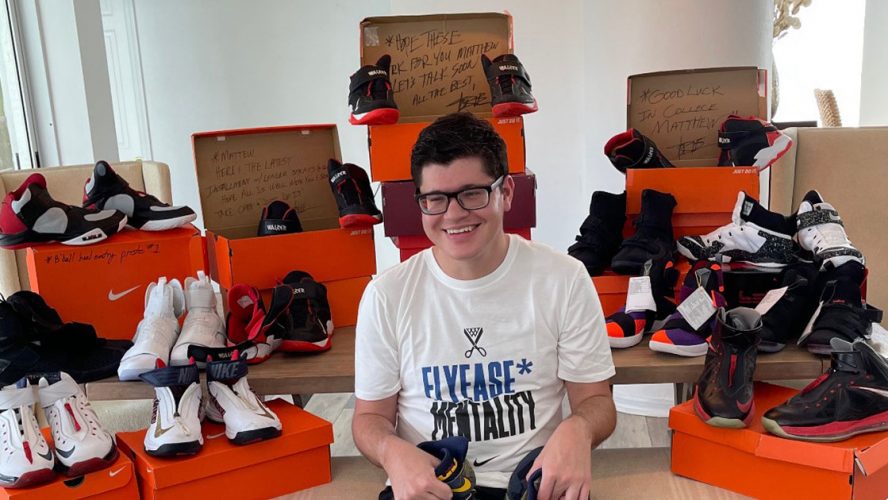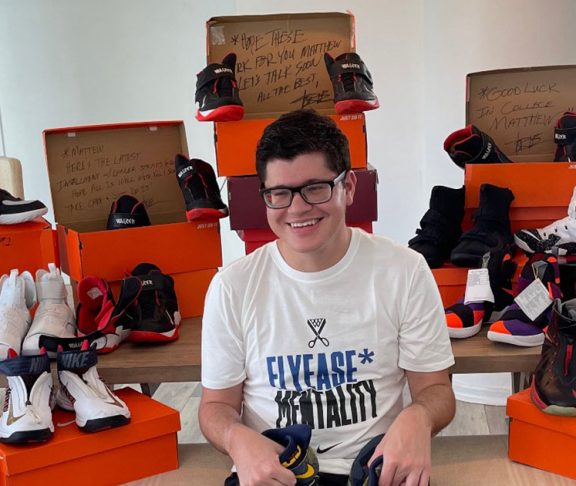When he was 18 years old, Matthew Walzer penned a viral letter to Nike to make shoes designed to be accessible for all — specifically for people with cerebral palsy (CP), like him. Walzer shared what being a disability advocate means to him, as well as some of the most impactful moments in his life.
Thinking back to your earliest memories as a young boy and your diagnosis, can you talk about how this time might have impacted your future?
I’ve never really thought about my CP in terms of how it affects me later in life and what it would prohibit me from doing. I’ve always made it a point to live in the here, in the now, and making the most of each day.
I was born two months premature and spent the first three-and-a-half months of my life in the NICU, and was diagnosed with spastic diplegia cerebral palsy essentially at birth. As a young boy, my parents made sure I had every opportunity to have the best quality of life possible.
Hours of physical therapy, Botox injections, and multiple surgeries before kindergarten — my parents stopped at nothing. Their dedication to my well-being helped instill in me that I can do anything I put my mind to.
Growing up, I never viewed my CP as all of the things that it’s stopped me from doing, or going to stop me from doing. I never thought, “I’m not going to get good grades, I’m not going to be able to drive, I won’t be able to go to college.” I’ve never had a negative mindset or a negative outlook on my future, and I attribute a lot of that to my upbringing.
What is something you would tell yourself if you could go back in time?
What may seem like adversity will become your greatest strength.
Can you talk about your activism, specifically your focus on accessibility, opportunity rights, and the importance of inclusion?
I have overcome many challenges in my life, but there is one that I was never able to overcome: tying my shoes. CP stiffens and tightens the muscles in the body, resulting in a lack of dexterity in my right hand, making shoe-tying impossible. As I got older, this became more and more frustrating.
In the summer of 2012, with college just around the corner and the goal of going away to school, I wrote an open letter to Nike asking for shoes that could be put on by everyone. The letter went viral (#NikeLetter), and what resulted was a three-year collaboration with Nike starting in 2012. I would give feedback and insights on rear-entry prototypes that Nike would send me, and give my input on materials, fit, support, cushioning, and more. What resulted was the first Flyease shoe that released in 2015, the Lebron Zoom Soldier 8 Flyease.
After the release, I had the honor of speaking at the White House under the Obama Administration for their Design For All event in 2016. I’ve also accepted awards from United Cerebral Palsy, the ARC, and others. I also was a judge for the Nike Ease Challenge in 2017. I have also appeared on the Drew Barrymore show, advocating for individuals with disabilities.
Writing that letter to Nike as a 16-year-old boy, and now looking back on it years later as a 25-year-old man, I am proud to be a voice for people with disabilities. I want people to view my letter as a source of hope and inspiration that anyone can make an impact. But I want my impact to go beyond just shoes.
Equality is so important, but so is equity. We need to ensure that people with disabilities are not only treated fairly, but have access to the tools, services, and resources that they need to have the best quality of life possible. For so long, people with disabilities have had to adapt to the world. Now I believe it is time for the world to start listening to the needs of people with disabilities to achieve equality AND equity. People with disabilities are such an overlooked minority, and that needs to stop.
What is one thing you are most proud of achieving within your life, either in your personal life or career?
Being able to help make a change that has impacted the lives of so many people in such a positive way. I want my letter to serve as an example and inspiration to those reading this, that any one person can make an impact on the world. Because of my disability, I’ve never been able to play sports competitively, but having the opportunity to collaborate with the largest sportswear brand in the world on the beginning of a line that has such an impact, and be the catalyst for such a needed change is incredible.
How do you think either the professional sports industry, or the athletic attire industry, can improve on inclusion and representation?
You can’t have success without competition, and so I think it’s important that more brands follow the lead of Nike and release more products with the adaptive market in mind. Not just in fashion, but everywhere. Transportation, infrastructure, our own government.
People don’t realize how complicated the car-buying process can be for someone with a disability. Instead of buying the car of our choice off of a dealer lot, we are limited to essentially a minivan, and then the car must get shipped to a third party to get any modifications we might need. This process can take about six months. It’s like we as people with disabilities are being penalized for being able to drive. Why aren’t auto manufacturers designing cars with disability in mind and streamlining such a cumbersome process?
Where do you see yourself in five years?
Continuing to help make a difference in the world and striving to keep breaking down barriers for people with disabilities. There is so much change that still needs to happen across various sectors, such as transportation, education, infrastructure, and even our own government.
Do you see yourself starting your own brand of some kind?
I want to continue advocating with other companies, sectors of government, and in education to move toward a better world.
What was your earliest memory of feeling great accomplishment, success, or excitement?
This might not be my earliest memory, but it is one of the most special things I’ve personally achieved. I am legally blind in my left eye, and have been since birth. I didn’t get my learner’s permit until I was 17 years old, after I had to pass multiple field of vision tests to be able to drive.
When I went back to the DMV over two years later to get my driver’s license, the people at the DMV were afraid to get in the car with me because of my vision issues, even though I had been driving my dad’s car for over two years. After convincing them to give me a driver’s test and explaining to them how hard I worked to get to this moment, they did give me a test.
The aggravation from pleading to get a test already made me have doubt in my mind and question if I would pass at all, no matter how many attempts I needed. I’m proud to say that on my one and only attempt to get my driver’s license, I passed with a perfect score and have no restrictions on my driver’s license.

